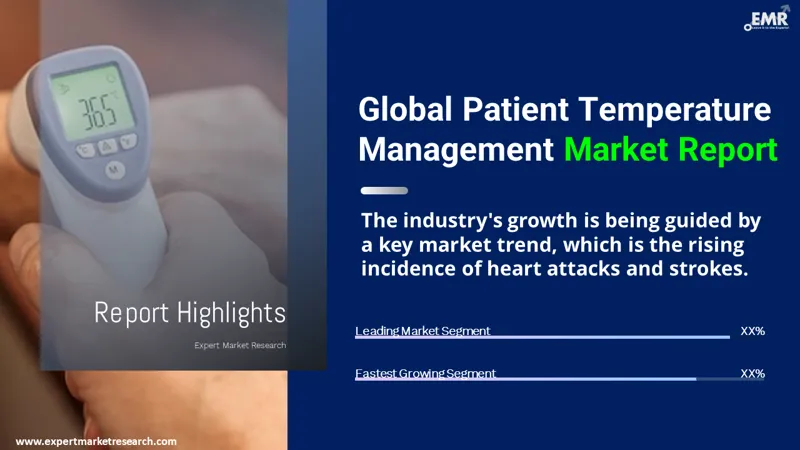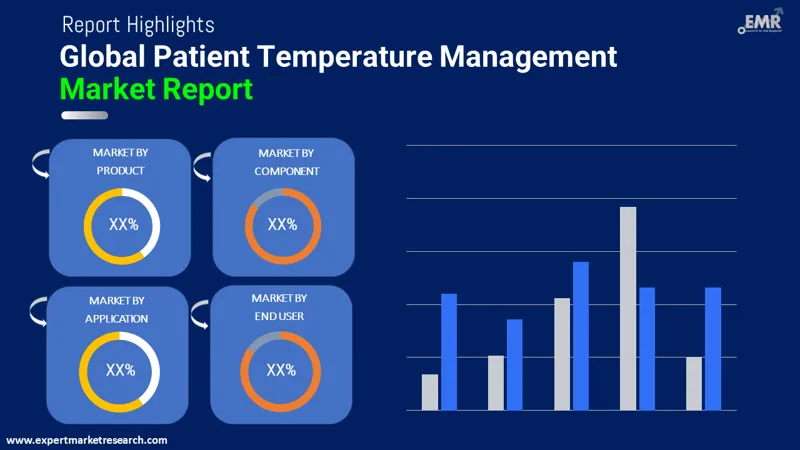
Consumer Insights
Uncover trends and behaviors shaping consumer choices today
Procurement Insights
Optimize your sourcing strategy with key market data
Industry Stats
Stay ahead with the latest trends and market analysis.
The growth of the global patient temperature management market size is being driven by the increasing awareness about the benefits of temperature management systems. The market attained a value of USD 4.35 Billion in 2025. The market value is anticipated to grow at a CAGR of 8.50% during the forecast period of 2026-2035, likely to attain a value of USD 9.84 Billion by 2035.
Base Year
Historical Period
Forecast Period
Compound Annual Growth Rate
8.5%
Value in USD Billion
2026-2035
*this image is indicative*
The industry is being driven by the growing prevalence of cardiovascular diseases and the rapid advancement in technology. The rising prevalence of cardiovascular diseases and cancer has encouraged the high demand for warming and cooling devices.

Read more about this report - REQUEST FREE SAMPLE COPY IN PDF
In order to protect patients from getting hypothermic, a continuous and effective patient warming is required to maintain their body temperature at normal levels (between 36.5º and 37.5º C) at all times. The global patient temperature management market can be divided based on different segments like:
Market Breakup by Product
Market Breakup by Component
Market Breakup by Application
Market Breakup by End User
Market Breakup by Region

Read more about this report - REQUEST FREE SAMPLE COPY IN PDF
The rise in the number of surgical procedures, the availability of technologically advanced products, and the increasing prevalence of cancer and cardiovascular diseases are the factors accelerating the growth of the patient temperature management industry globally. Patient warming systems, radiation therapy, and chemotherapy are used to prevent the drop in body temperature in cancer patients. In addition, the increasing incidences of heart attack and stroke are also considered as a significant growth driver for the market. During instances of stroke or heart attack, the body needs to be relatively cooler to increase the survival rate and enable normal brain functioning. However, the high cost of patient temperature management systems is the drawback that may affect the market growth in the forecast period.
The report presents a detailed analysis of the following key players in the global patient temperature management market, looking into their capacity, market shares, and latest developments like capacity expansions, plant turnarounds, and mergers and acquisitions:
The EMR report gives an in-depth insight into the industry by providing a SWOT analysis as well as an analysis of Porter’s Five Forces model.




*While we strive to always give you current and accurate information, the numbers depicted on the website are indicative and may differ from the actual numbers in the main report. At Expert Market Research, we aim to bring you the latest insights and trends in the market. Using our analyses and forecasts, stakeholders can understand the market dynamics, navigate challenges, and capitalize on opportunities to make data-driven strategic decisions.*
Get in touch with us for a customized solution tailored to your unique requirements and save upto 35%!
In 2025, the global patient temperature management market attained a value of nearly USD 4.35 Billion.
The market is projected to grow at a CAGR of 8.50% between 2026 and 2035.
The major drivers of the industry, such as the growing prevalence of cardiovascular diseases, the rapid advancement in technology, rise in the number of surgical procedures, and the availability of technologically advanced products, are expected to aid the market growth.
The key market trend guiding the industry growth includes the increasing incidences of heart attack and stroke.
The major regions in the industry are North America, Latin America, the Middle East and Africa, Europe, and the Asia Pacific.
The major products of patient temperature management in the industry are patient warming systems and patient cooling systems.
The major end uses of the product in the market are operating room, neonatal ICU, emergency room, and ICU, among others.
The major players in the industry are Stryker Corporation, Zoll Medical Corporation, Medtronic plc, Gentherm Inc., 3M Company, Becton, Dickinson and Company, Geratherm Medical AG, 3M Company, Others.
Explore our key highlights of the report and gain a concise overview of key findings, trends, and actionable insights that will empower your strategic decisions.
| REPORT FEATURES | DETAILS |
| Base Year | 2025 |
| Historical Period | 2019-2025 |
| Forecast Period | 2026-2035 |
| Scope of the Report |
Historical and Forecast Trends, Industry Drivers and Constraints, Historical and Forecast Market Analysis by Segment:
|
| Breakup by Product |
|
| Breakup by Component |
|
| Breakup by Application |
|
| Breakup by End User |
|
| Breakup by Region |
|
| Market Dynamics |
|
| Supplier Landscape |
|
| Companies Covered |
|
Datasheet
One User
USD 3,299
USD 2,969
tax inclusive*
Single User License
One User
USD 5,499
USD 4,949
tax inclusive*
Five User License
Five User
USD 6,999
USD 5,949
tax inclusive*
Corporate License
Unlimited Users
USD 8,199
USD 6,969
tax inclusive*
*Please note that the prices mentioned below are starting prices for each bundle type. Kindly contact our team for further details.*
Flash Bundle
Small Business Bundle
Growth Bundle
Enterprise Bundle
*Please note that the prices mentioned below are starting prices for each bundle type. Kindly contact our team for further details.*
Flash Bundle
Number of Reports: 3
20%
tax inclusive*
Small Business Bundle
Number of Reports: 5
25%
tax inclusive*
Growth Bundle
Number of Reports: 8
30%
tax inclusive*
Enterprise Bundle
Number of Reports: 10
35%
tax inclusive*
How To Order

Select License Type
Choose the right license for your needs and access rights.

Click on ‘Buy Now’
Add the report to your cart with one click and proceed to register.

Select Mode of Payment
Choose a payment option for a secure checkout. You will be redirected accordingly.
Gain insights to stay ahead and seize opportunities.

Get insights & trends for a competitive edge.

Track prices with detailed trend reports.

Analyse trade data for supply chain insights.

Leverage cost reports for smart savings

Enhance supply chain with partnerships.

Connect For More Information
Our expert team of analysts will offer full support and resolve any queries regarding the report, before and after the purchase.
Our expert team of analysts will offer full support and resolve any queries regarding the report, before and after the purchase.
We employ meticulous research methods, blending advanced analytics and expert insights to deliver accurate, actionable industry intelligence, staying ahead of competitors.
Our skilled analysts offer unparalleled competitive advantage with detailed insights on current and emerging markets, ensuring your strategic edge.
We offer an in-depth yet simplified presentation of industry insights and analysis to meet your specific requirements effectively.
Share